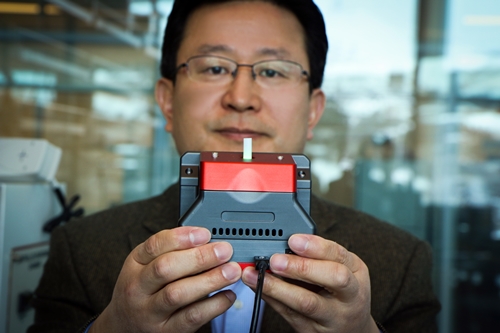
Ling Zang holds prototype detection device by his company, Vaporsens (Dan Hixson, University of Utah)
28 March 2016. A University of Utah engineering team designed a new ultra-sensitive material that can detect traces of hydrocarbon fuel or explosive vapors in the air. Researchers from the lab of Ling Zang published their findings earlier this month of the journal ACS Sensors; paid subscription required.
Zang, a professor of engineering and materials science in Salt Lake City, is also on the faculty at Utah Science, Technology and Research (USTAR) economic development initiative. In addition, Zang is chief scientist at the spin-off company Vaporsens that licensed his research discoveries on vapor detection and is developing commercial sensors mainly for security applications.
In this case, the team is aiming for a simple way to identify vapors from alkanes, inert hydrocarbon building blocks that when detected can indicate leaks from pipelines or fuel lines in aircraft, or the presence of hidden explosives. Current alkane detection technologies, Zang notes, are large — about the size of an oven — heavy, and not mobile. “There’s no way it can be used in the field,” says Zang in a university statement. “Imagine trying to detect the leak from a gas valve or on the pipelines. You ought to have something portable.”
To make it possible for a portable device to sense alkanes in the air under ambient conditions, Zang and colleagues developed a composite of nanoscale fibers that react to light as well as the presence of alkanes. The composite material first attracts alkane molecules in the air, then reacts to the alkane by disrupting the electric charge through the fibers first started by the presence of light.
In their paper, the team demonstrated the material could detect minute alkane traces at room temperature. In addition, the researchers found they could tune the composite material to identify different types of vapors based on their alkane chemistry. Devices could then load predefined profiles of alkane gases for detection and identification.
Vaporsens is developing sensors that apply this approach and technology. The company says it is developing some 30 different nanofibers that it can package in a detection device, with sensors for different vapors swapped out like memory cards in a camera.
Read more:
- Biodegradable Brain Sensors Developed, Tested
- €50,000 Challenge Seeks New Gas Technologies
- Researchers Develop Eye Injury Test, Start Company
- Implanted Sensor to Measure Blood Sugar in Development
- Nanotech Sensors Devised for RNA Cancer Detection
* * *

 RSS - Posts
RSS - Posts
You must be logged in to post a comment.